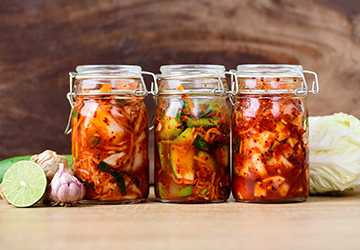Top 10 Fermentation Tips for Beginners: Kimchi, Sauerkraut & More!
Fermentation, a culinary practice steeped in history, has been experiencing a resurgence of late. Transforming essential ingredients into intricate, flavorful delights through microbial activity is tasty and highly beneficial to our health. Fermented foods like kimchi and sauerkraut are packed with probiotics that boost gut health and overall wellness.
If you're new to the world of fermentation, don't worry! This guide will provide the top 10 tips for successful fermentation, ensuring your foray into this time-honored tradition is a triumph. So, let's dive into the fascinating world of fermentation!
Fermentation Tips for Beginners: Kimchi, Sauerkraut & More!
Fermentation, an ancient culinary tradition that has captivated taste buds for centuries, is experiencing a vibrant resurgence. This timeless art of transforming humble ingredients into exquisite, complex flavors through the action of microorganisms is not only delicious but also profoundly beneficial for our well-being. The world of fermentation welcomes beginners with open arms, offering a diverse array of tempting options, from the tangy allure of sauerkraut to the fiery zest of kimchi.
If you're starting your journey into the intriguing realm of fermentation, you've come to the right place. This article will unveil the top 10 tips for your enchanting fermenting voyage.

1.Start Simple: Master Sauerkraut First
Fermentation with various recipes and techniques can initially seem intimidating. To ease into the world of fermentation, start with sauerkraut. This traditional fermented cabbage dish is incredibly straightforward, making it an excellent gateway for beginners. All you need is cabbage, salt, and a jar. Shred the cabbage, mix it with salt, pack it into the jar, and let time and nature work their magic. You'll be amazed by the tangy, crisp result.
2.Use High-Quality Ingredients
The quality of your ingredients can make or break your fermentation project. Opt for organic vegetables containing more naturally occurring microbes that aid fermentation. Ensure your salt is free of additives like iodine or anti-caking agents. For the best results, invest in sea salt or kosher salt. The purer the ingredients, the better your fermented foods' flavor and nutritional value.
3.Sterilize Your Equipment
Ensuring your equipment is thoroughly sterilized is vital in preventing the development of detrimental bacteria and molds during fermentation. It's essential to clean your jars, lids, and utensils using hot, soapy water, followed by a comprehensive rinse. For an added layer of safety, consider putting them through a dishwasher cycle or boiling them for several minutes. Maintaining a clean environment is critical to fostering a healthy fermentation process.
4.Pay Attention to Time and Temperature
Temperature and time are two essential factors in fermentation. Different microbes thrive at different temperatures, so finding a suitable range for your chosen recipe is necessary. Most vegetable ferments are typically done at room temperature, around 65-75°F (18-24°C). Keep an eye on your ferments, as higher temperatures speed up the process, while lower temperatures slow it down.
5.Experiment with Flavors
One of the most exciting aspects of fermentation is the ability to experiment with flavors. While traditional recipes are delicious, feel free to get creative. Add spices, herbs, and fruits to your ferments to create unique taste profiles. For example, try adding caraway seeds to your sauerkraut or red pepper flakes to your kimchi. These subtle touches can elevate your creations to a whole new level.
6.Use an Airlock System
Fermentation is a process that takes place in an oxygen-free or anaerobic environment. Consider using an airlock system to create the perfect conditions for fermenting foods. These uncomplicated devices are designed to release naturally produced gases during fermentation while keeping air from entering your jars. This helps to reduce the chances of unwanted contamination significantly and ensures more reliable outcomes in your fermentation endeavors.

7.Pack Your Ferments Tightly
To promote an anaerobic environment, it's essential to pack your ferments tightly into their containers. Use a tamper or clean hands to press the ingredients down, releasing their juices and eliminating air pockets. This step helps to create an environment where beneficial lactic acid bacteria can thrive while inhibiting the growth of harmful microorganisms.
8.Monitor and Taste Your Ferments
Fermentation is a dynamic process, and the flavors of your creations will evolve. To find your ideal taste, it's crucial to monitor your ferments. Taste them regularly, starting from a few days in and continuing until you're satisfied with the flavor. Once you reach your desired taste, move your ferments to the refrigerator to slow fermentation.
9.Embrace the Beauty of Imperfection
Fermentation is not an exact science, and each batch can turn out slightly different due to various factors like temperature, humidity, and even the microorganisms in your environment. Don't be discouraged if things don't go as planned, as this is all part of the learning process. Embrace the beauty of imperfection and be open to the unique flavors that emerge from your experiments.
10.Share Your Knowledge and Creations
Fermentation is a communal activity that has been passed down through generations. As you embark on your fermentation journey, remember to share your newfound knowledge and creations with friends and family. Not only will this foster a sense of community, but it will also introduce others to the joys of fermentation. Start a fermentation club or host tasting events to showcase your skills.
Conclusion
Embarking on the fermentation journey is an intriguing and gratifying culinary experience accessible to all. By mastering the correct methods and exercising patience, you can produce a variety of delectable and healthful foods such as sauerkraut, kimchi, and kombucha, among others. It's crucial to begin with straightforward recipes, utilize top-notch ingredients, ensure your tools are sterilized, and carefully monitor the duration and temperature.
Feel free to play around with different tastes, employ airlock systems for fermentation, pack your ferments firmly, and appreciate the charm of irregularities. Above all, spread the joy by sharing your expertise and homemade delights with others. This will set you on a path towards becoming a fermentation connoisseur. Enjoy your fermentation journey!


